Site Challenges in Eastern Europe
Applied Clinical Trials
Survey sheds light on the regional-specific risks of managing clinical trial sites in Eastern Europe.

Until the end of the 1990s, the majority of clinical sites were based in traditional regions such as Western Europe and North America. In the last two decades, the geographic area of clinical trials has expanded to include more sites in other regions. Today, many sponsors include Eastern European sites in their multinational Phase III studies. In this article, we use the term Eastern Europe to include the Ukraine, Belarus, Russia, Moldova, and Georgia-those countries that inherited and still utilize post-USSR management style, healthcare system structure, and corporate culture. These sites offer the benefit of high recruitment rates, moderate costs, and large treatment-naïve populations, as well as motivated investigators and quality data.1
But we believe there are still challenges facing sponsors in dealing with sites in this region. To overcome and address these hurdles, we sought to clearly understand regional-specific risks and challenges. Our purpose was to evaluate actual site performance in Eastern Europe in comparison with other core clinical trial regions to determine whether Eastern European countries are still considered attractive destinations for clinical trials from pharmaceutical and contract research organization (CRO) viewpoints.
Methods
A web-based survey was conducted among clinical trial professionals from more than 20 countries in North America, South America, Asia, and Europe. The survey consisted of six question categories to determine the following:
- Main location and experience of responders.
- How often responders are facing site-specific issues that affects their study course.
- Differences between clinical sites in various geographic areas.
- Differences between clinical sites with respect to different therapeutic areas in Eastern Europe region.
- Typical site-specific challenges in Eastern Europe.
- Possibility and main reason to involve sites from this region for prospective clinical trials.
Clinical sites were attributed to three categories according to the nature and severity of the detected issues:
- No problem - sites with a negligible number of rarely arising issues that can be easily resolved, and which affects neither the quality nor timelines of the collected data.
- Moderately problematic - sites with medium expression of problems, where issues are systemic, appear quite often, and require time and effort to resolve. These clinical sites may require extra attention, but with specific controls put into place, issues can be resolved and do not largely affect quality of data and study conduct.
- Highly problematic - sites where issues that might significantly affect quality and timelines are common. These study sites require continuous quality control.
Respondents were selected based on information from LinkedIn profiles and the authors’ personal network. Overall, 57 replies were collected during the period from September 2014 until January 2015. More than 90% (92.15%) of respondents had managerial experience in more than five projects. The majority, approximately three quarters (72.55%), had managed more than 10 projects.
Results
Main geographic regions were assessed in terms of issues that arise at clinical trial sites. Figure 1 illustrates the rating of core clinical trials regions from a site-specific perspective.
Figure 1
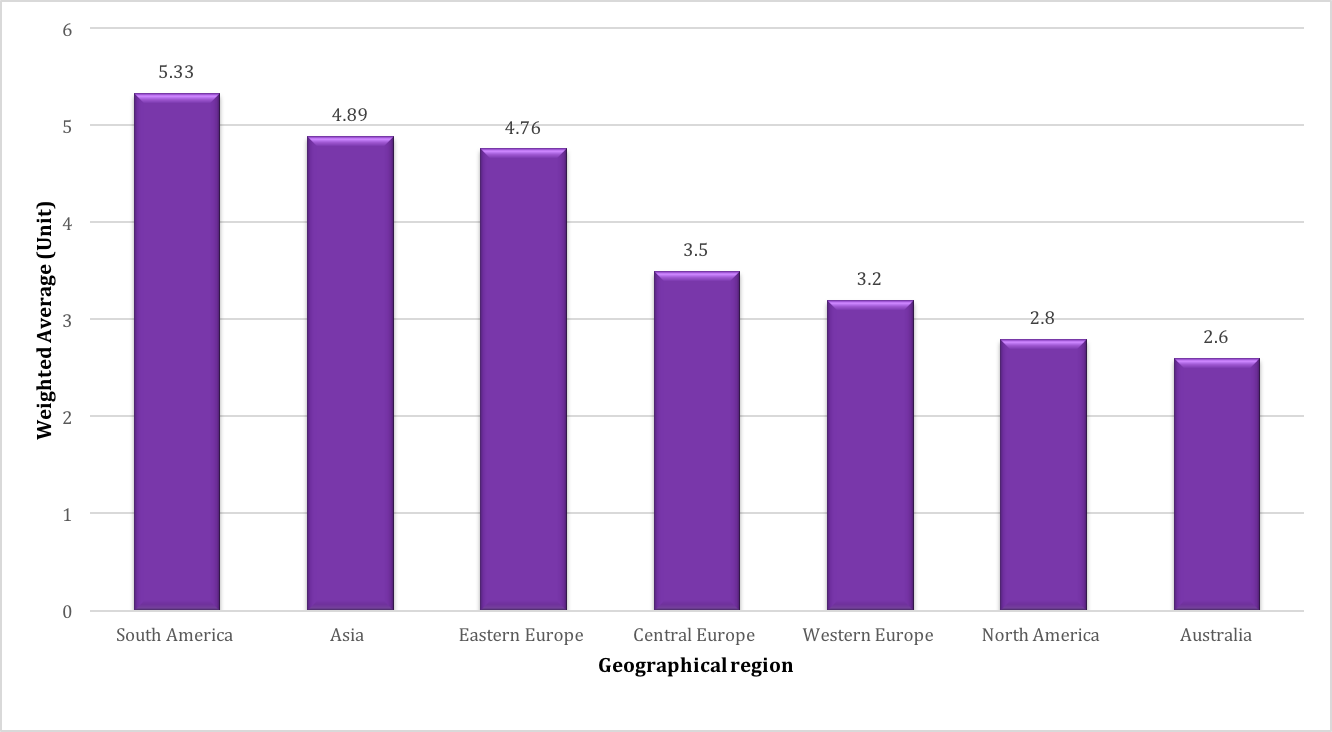
Figure 1
The weighted average reflects a level of problems in a specific region-the higher weighted average value, the more problematic the region. Based on results of the survey, sites with fewer problems were based in Australia and North America, while the most problematic sites were based in South America and Asia.
The survey revealed that site performance is a serious challenge even in traditional and “clinically prosperous” regions. The survey showed that a combined 36% of sites in Australia and 37.5% of sites in North America were considered “Moderately” and “Highly” problematic, requiring close monitoring and additional site-management efforts. In comparison, 78% of sites in Eastern Europe were considered “Medium” or “Highly” problematic (see Figure 2).
Figure 2
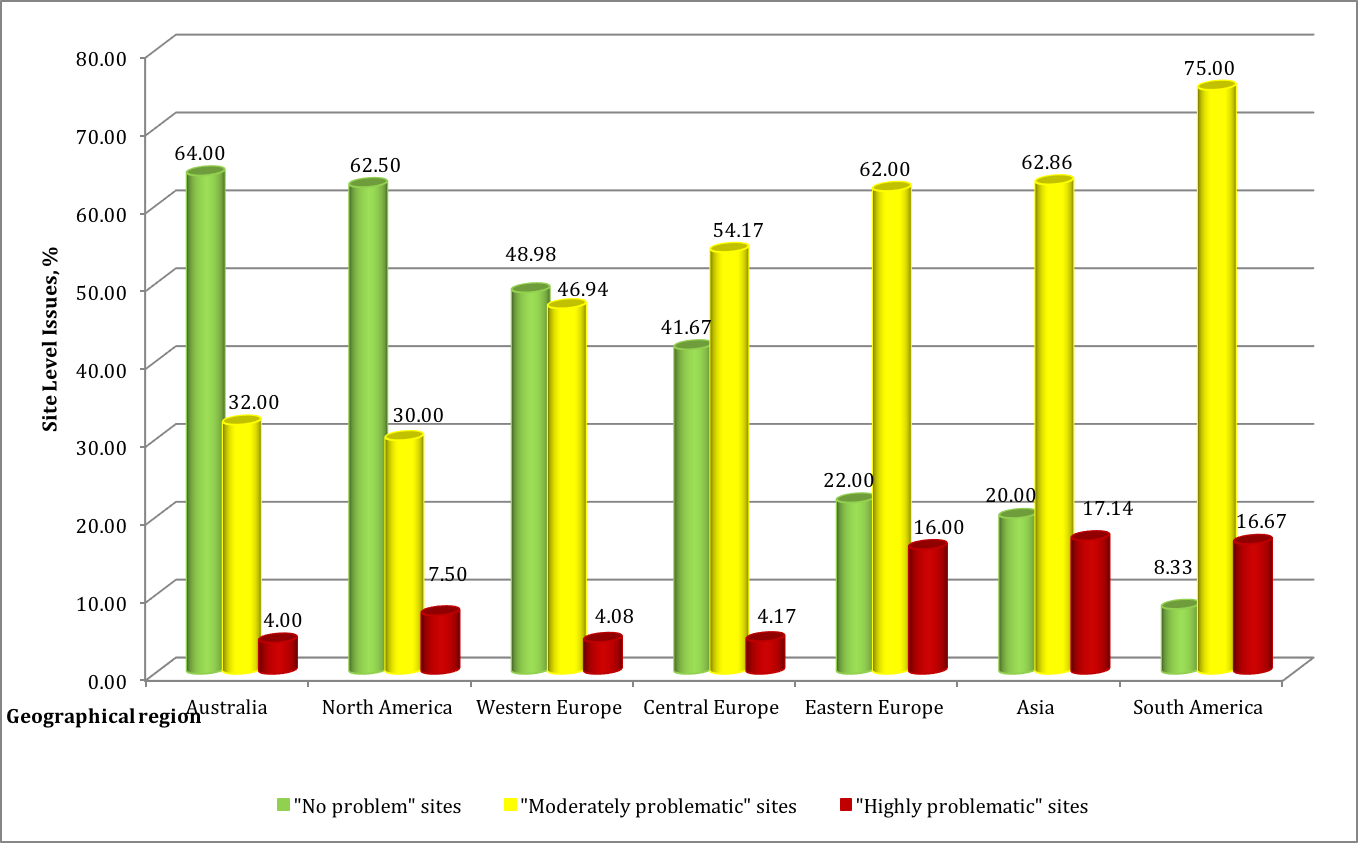
Figure 2
The data confirmed that sites in different regions require different levels of site management, with those in traditional clinical site regions requiring less effort, and those in newer emerging regions, such as Eastern Europe and South America, requiring greater input from sponsors and CROs.
One of the objectives of the survey was to explore whether any discrepancies in performance between sites exists, with respect to different therapeutic areas. The majority of respondents admitted such dissimilarity (See Figure 3).
Figure 3

Figure 3
The replies suggested that oncology clinical sites are most challenging in terms of performance. This could be explained by the highest saturation of trials in this therapeutic area, and the generally extensive routine workload of oncology specialists.
We then examined why Eastern Europe is still underutilized with respect to clinical research site potential. Respondents acknowledged that diverse and complicated contract procedures with study sites and investigators present
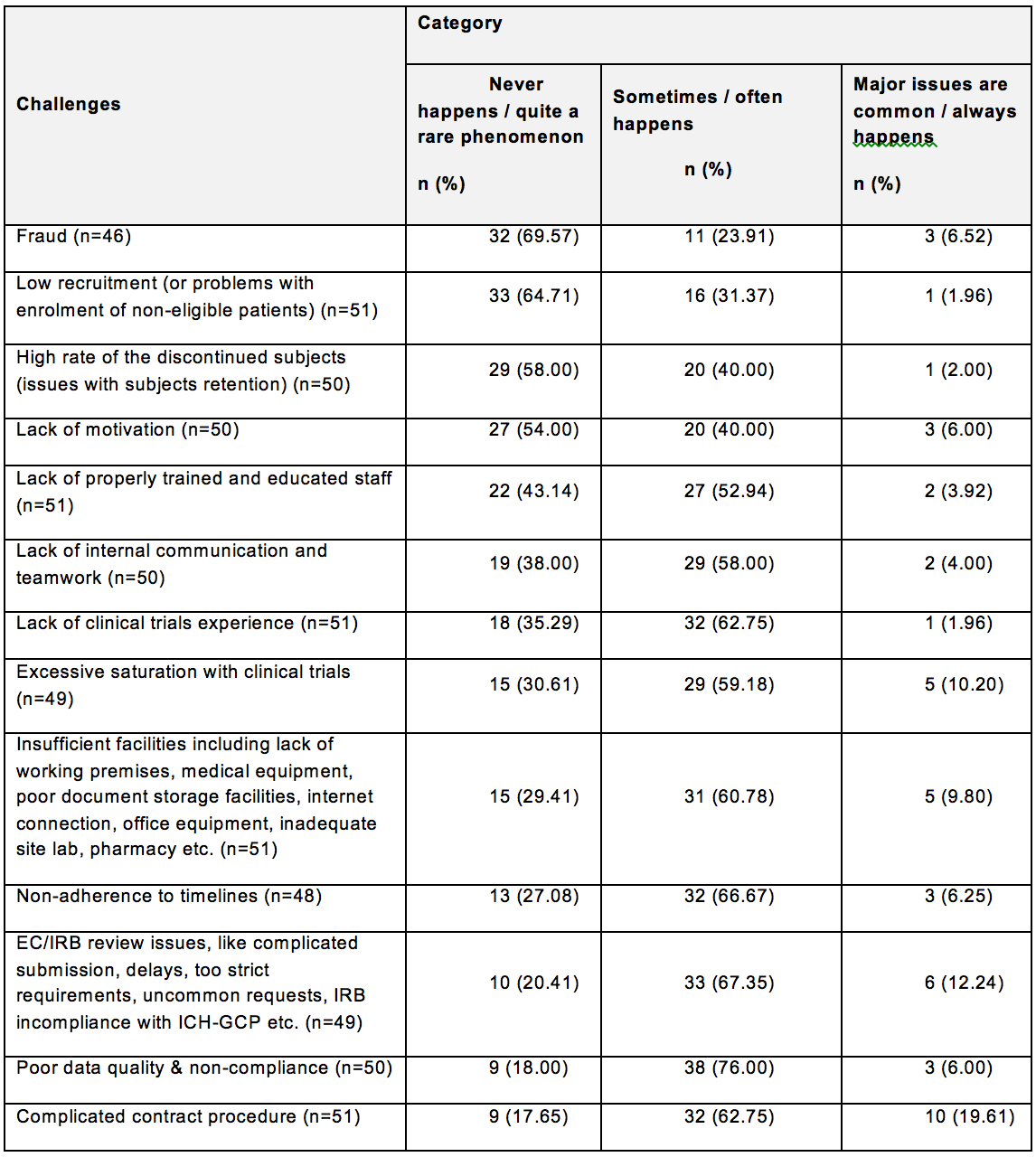
significant challenge for CROs and sponsors (see table at right; click here to enlarge). Furthermore, at state hospitals, which represent the greater majority of the study sites, management and investigators regularly undervalue the importance of contractual obligations that affect timelines and might delay initiation at an individual site.
About 80% of respondents admitted facing this problem, and for almost 20%, it is a recurrent and crucial hurdle that potentially might influence prospective collaboration with the study centers. Table 1 presents the prevalence of typical site-specific challenges in this region.
Liaison with local ethics committees (ECs) has been recognized as another specific challenge in Eastern Europe. Quite often, these relationships are underestimated and might be neglected by investigators. However, in this region, it is not a common practice to delegate administrative and technical tasks associated with ECs to a dedicated study coordinator, as such posts do not exist in clinics and hospitals. These tasks are often performed by sub-investigators, who have to manage patients as well as administrative tasks.
Our survey revealed that some study sites are poorly resourced and inadequately supplied. In some cases, clinical sites may lack basic tools such as access to the Internet or fax. This could be due to lack of support and restricted funding from state governments; a lack of motivation to investing internally by investigators and local hospital management; or a lack of focus or knowledge of changing market factors. Specifically, if the increasing requirements that sponsors place on clinical study sites are ignored by the Eastern European professionals, the sites inevitably will be a less attractive option to sponsors.
The respondents acknowledged a positive trend for involving sites in Eastern Europe in clinical trials and growing the clinical research experience of these centers. More than 35% of sites in the region were considered to have sufficient level of experience in the industry-sponsored clinical studies, and over 40% of sites have adequately-trained personnel.
Teamwork defined as smooth integrated functioning of the involved parties has always been considered challenging in medicine and science. Eastern European clinical investigators are not an exception of this rule. Sixtyâtwo percent of survey respondents noticed a lack of teamwork at sites in Eastern Europe.
The respondent data presented in Table 1 provides a snapshot of a typical Eastern European clinical study site from the viewpoint of an international CRO or pharmaceutical company. It can be summarized as follows:
- Not always well-equipped site that is still keen to participate in a clinical trial; can ensure fast enrollment and high patient retention rates; committed to generate good quality data; often tends to neglect applicable regulatory agency (RA)/EC reporting procedures; with overloaded site staff; where internal miscommunication is not rare, and might affect adherence to timelines, quality, and compliance; Sponsors often heavily struggle executing Clinical Trial Agreement with the site due to complicated local legal and administrative procedures.
In spite of the above listed challenges, over 43% of survey respondents confirmed that they would definitely include Eastern European clinical sites in their trials. About 30% of respondents indicated that likelihood is very high (see Figure 4).
Figure 4
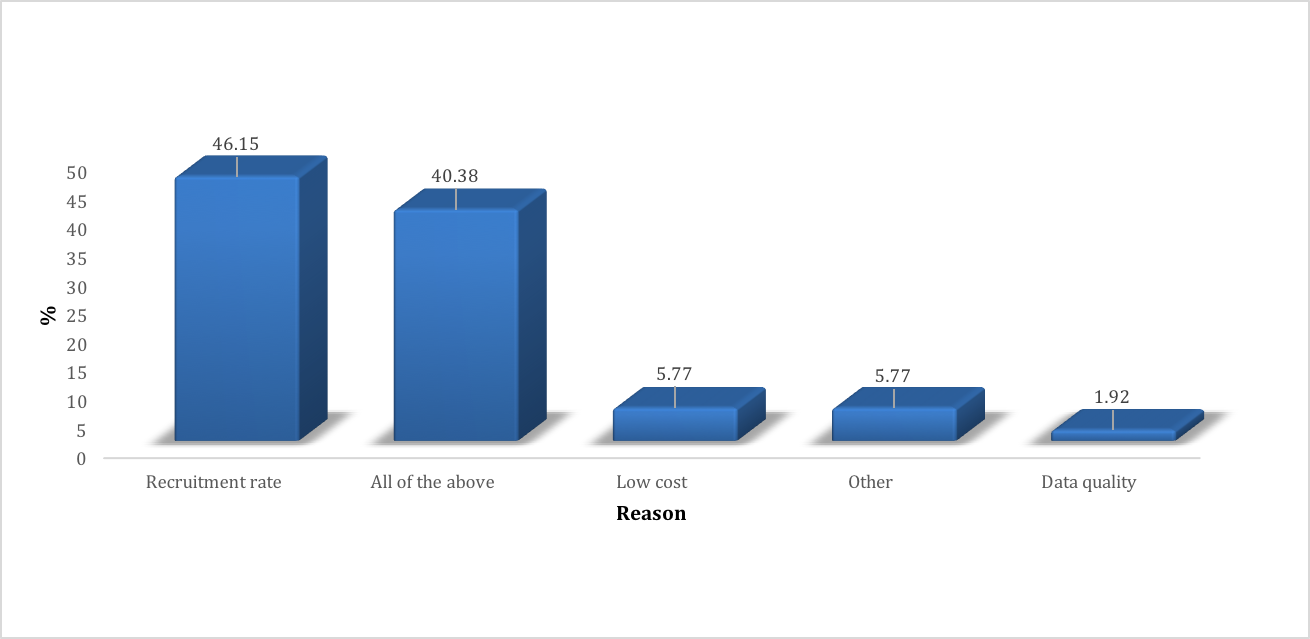
quality of data (see Figure 5 at right; click here to enlarge).
Conclusion
Regardless of the number of challenges that CROs and pharma companies are facing in Eastern Europe, their clinical trial activities still remain high. Moreover, this geographic area continues to attract companies based on the following factors:
- High recruitment rates driven by (a) centralized healthcare system that facilitates concentration of patients in large specialized hospitals; and (b) large treatment-naïve population eager to get access to innovative treatments.
- Motivated investigators.
- Moderate per-patient costs and investigator fees.
The following three factors may have an impact on Eastern Europe’s ability to attract trials in the near future:
- Global competition between regions becoming apparent as pharmaceutical and biotechnology companies are shifting R&D activities to emerging markets such as Asia in order to achieve further cost reduction in drug development process.1
- With development of information technologies and advances in study procedures becoming more complicated, it raises the qualification threshold for site staff and facilities.
- Sponsors are decisively reducing expenditures in site management by implementing cost-saving monitoring models. In such models, such as risk-based monitoring (RBM), where the role of the clinical monitor changes and is not on-site as often, this may be challenging for those Eastern European sites with scarce internal resources. Also, it may affect the ability to manage studies utilizing complex protocols where continuous oversight and support are required.
We believe that sites in Eastern Europe can meaningfully contribute to global clinical programs. However, investigators, hospital management, and regulators have to acknowledge the existing local limitations, and focus on improving them. We believe that study centers should modify structure, procedures, and performance to the rapidly changing global clinical research environment.
We acknowledge the repeatedly published favorable outcomes of FDA inspection in Eastern Europe and appreciate that results of our survey are not mirroring findings provided by the authority. Also, the data collected by authors are based on the personal perception and experience of 57 respondents and not on results of official inspections. Nevertheless, we believe that the results presented here should be considered by sponsors, authorities, auditors, CROs, and sites.
Nikolay Grechko, MD, is Clinical Research Consultant (London, UK); Kateryna Bezditko, PharmD, PhD, is Associate Professor at National University of Pharmacy (Kharkiv, Ukraine); Sergii Myronenko*, MD, is CEO of PharmaSich CRO (Kyiv, Ukraine), email: smyronenko@pharmasich.com
* To whom all correspondence should be addressed
Reference
1. Maxim Belotserkovsky, Tomas Novak, Ginny Payeur. Decline of Clinical Trials in Central and Eastern Europe: Fluctuation or Trend? Applied Clinical Trials. Jun 16, 2014. http://www.appliedclinicaltrialsonline.com/decline-clinical-trials-central-and-eastern-europe-fluctuation-or-trend
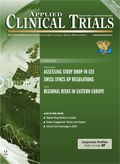
Improving Relationships and Diversifying the Site Selection Process
April 17th 2025In this episode of the Applied Clinical Trials Podcast, Liz Beatty, co-founder and chief strategy officer, Inato, discusses a number of topics around site engagement including community-based sites, the role of technology in improving site/sponsor relationships, how increased operational costs are impacting the industry, and more.
Behind the Buzz: Why Clinical Research Leaders Flock to SCOPE Summit
February 7th 2025In this episode, we meet with Micah Lieberman, Executive Conference Director for SCOPE Summit (Summit for Clinical Ops Executives) at Cambridge Innovation Institute. We will dive deep into the critical role of collaboration within the clinical research ecosystem. How do we bring together diverse stakeholders—sponsors, CROs, clinical trial tech innovators, suppliers, patients, sites, advocacy organizations, investors, and non-profits—to share best practices in trial design, program planning, innovation, and clinical operations? We’ll explore why it’s vital for thought leaders to step beyond their own organizations and learn from others, exchanging ideas that drive advancements in clinical research. Additionally, we’ll discuss the pivotal role of scientific conferences like SCOPE Summit in fostering these essential connections and collaborations, helping shape the future of clinical trials. Join us as we uncover how collective wisdom and cross-industry partnerships are transforming the landscape of clinical research.